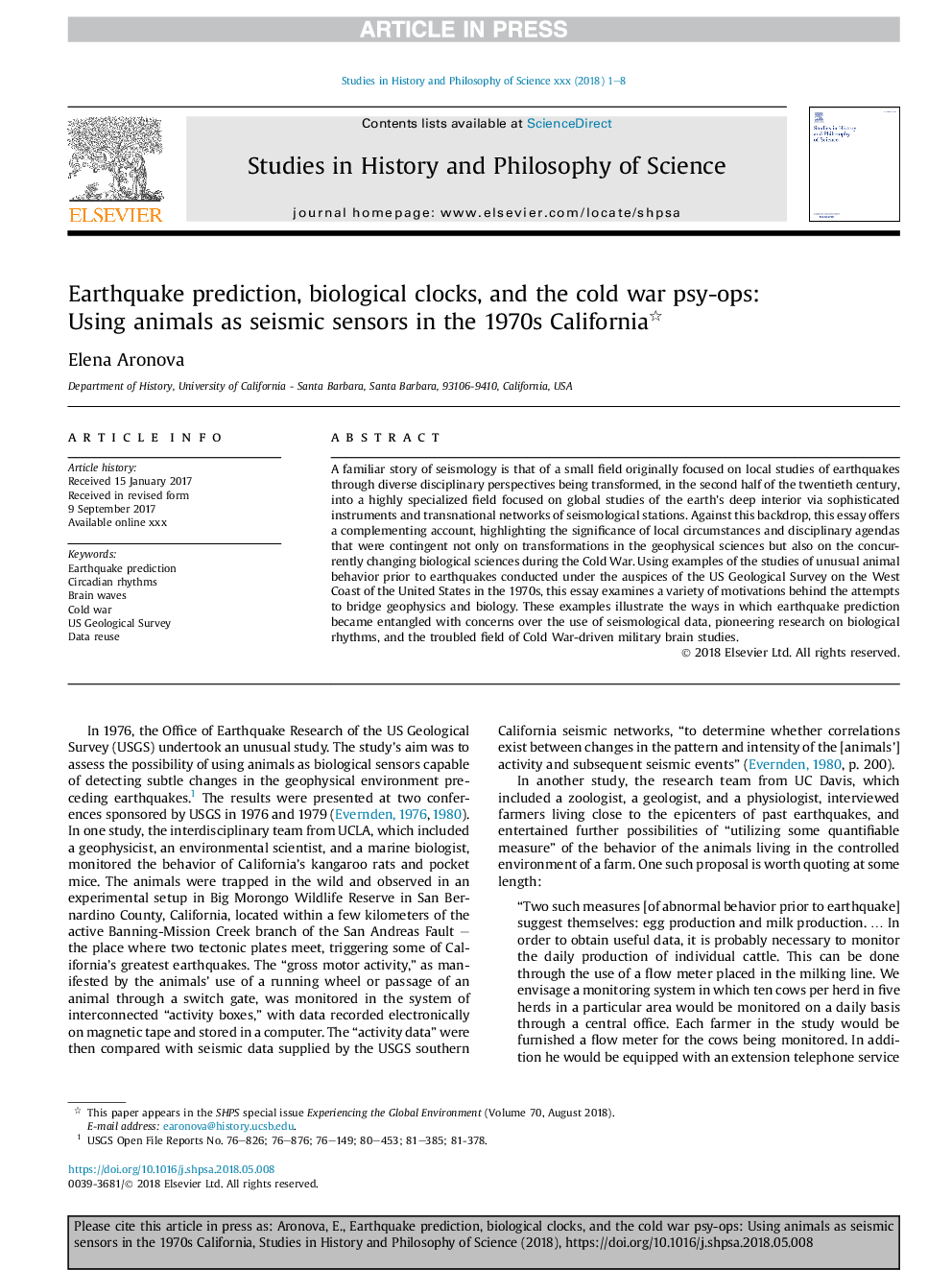| کد مقاله | کد نشریه | سال انتشار | مقاله انگلیسی | نسخه تمام متن |
|---|---|---|---|---|
| 8942600 | 1645107 | 2018 | 8 صفحه PDF | دانلود رایگان |
عنوان انگلیسی مقاله ISI
Earthquake prediction, biological clocks, and the cold war psy-ops: Using animals as seismic sensors in the 1970s California
ترجمه فارسی عنوان
پیش بینی زلزله، ساعت های بیولوژیکی و جنگ های سرد جنگ های صلیبی: استفاده از حیوانات به عنوان سنسورهای لرزه ای در دهه 1970 کالیفرنیا
دانلود مقاله + سفارش ترجمه
دانلود مقاله ISI انگلیسی
رایگان برای ایرانیان
کلمات کلیدی
پیش بینی زلزله، ریتم های دورانی، امواج مغزی، جنگ سرد، زمین شناسی ایالات متحده، استفاده مجدد از داده ها،
ترجمه چکیده
داستان آشنا لرزه شناسی این است که یک میدان کوچک در اصل بر مطالعات محلی زمین لرزه ها با توجه به دیدگاه های انضباطی متفاوتی که در نیمه دوم قرن بیستم به یک منطقه بسیار متمرکز بر مطالعات جهانی درون عمیق زمین با استفاده از پیچیده ابزار و شبکه های بین المللی ایستگاه های زلزله شناسی. در این زمینه، این مقاله، یک مکمل را ارائه می دهد که اهمیت شرایط محلی و برنامه های انضباطی را برجسته می کند که نه تنها بر تغییرات در علوم ژئوفیزیک بلکه همچنین علوم زیست شناختی همزمان در طول جنگ سرد بستگی دارد. با استفاده از نمونه هایی از مطالعات رفتار حیوانات غیر معمول قبل از زمین لرزه های انجام شده تحت نظارت سازمان زمین شناسی ایالات متحده در ساحل غربی ایالات متحده در دهه 1970، این مقاله انگیزه های مختلفی را در پشت تلاش های پلان ژئوفیزیک و زیست شناسی بررسی می کند. این نمونه ها راه هایی را نشان می دهد که پیش بینی زلزله با نگرانی ها در مورد استفاده از داده های زلزله شناسی، تحقیقات پیشگام در مورد ریتم های بیولوژیکی و زمینه مشکل تحقیقات مغز نظامی نظامی تحت هدایت جنگ سرد متجلی شد.
موضوعات مرتبط
علوم انسانی و اجتماعی
علوم انسانی و هنر
تاریخ
چکیده انگلیسی
A familiar story of seismology is that of a small field originally focused on local studies of earthquakes through diverse disciplinary perspectives being transformed, in the second half of the twentieth century, into a highly specialized field focused on global studies of the earth's deep interior via sophisticated instruments and transnational networks of seismological stations. Against this backdrop, this essay offers a complementing account, highlighting the significance of local circumstances and disciplinary agendas that were contingent not only on transformations in the geophysical sciences but also on the concurrently changing biological sciences during the Cold War. Using examples of the studies of unusual animal behavior prior to earthquakes conducted under the auspices of the US Geological Survey on the West Coast of the United States in the 1970s, this essay examines a variety of motivations behind the attempts to bridge geophysics and biology. These examples illustrate the ways in which earthquake prediction became entangled with concerns over the use of seismological data, pioneering research on biological rhythms, and the troubled field of Cold War-driven military brain studies.
ناشر
Database: Elsevier - ScienceDirect (ساینس دایرکت)
Journal: Studies in History and Philosophy of Science Part A - Volume 70, August 2018, Pages 50-57
Journal: Studies in History and Philosophy of Science Part A - Volume 70, August 2018, Pages 50-57
نویسندگان
Elena Aronova,
